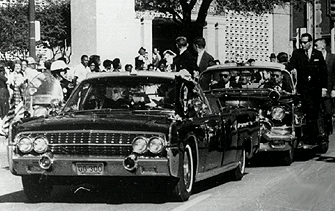Introductory
Featured Articles
References
|
The Assassination: An Overview
During his electoral battle tour in the south of the States, John F.
Kennedy visited Dallas (Texas) on November 22, 1963. On his arrival at 1140
hours, he was warmly welcomed by the people of Dallas. Kennedy, Governor
John Connally and their wives sat down in the limousine of the President
which led the motorcade through the town.
 Zapruder frame 335: The fatal head shot
Zapruder frame 335: The fatal head shot
When the motorcade arrived in Dealey Plaza at 1230 hours, it turned right
from Main to Houston Street and just seconds later it took the 120 degree
turn into Elm Street passing the Schoolbook Depository Building.
Just when the limousine passed the Stemmons Freeway sign, Mrs. Connally
heard a kind of gunshots. When she turned looking at the President, she saw
him taking his hand to his throat covering a shooting wound. The next
second Governor Connally felt an ache in his back which he recognized as a
shot. He later said:
...there were either two or three people involved or more in this or
someone was shooting with an automatic rifle.
Just seconds later he could hear the third shot. Mrs. Kennedy who then
believed she listened to firecrackers from the motorcade, heard this moment
"terrible noises" and turned to Kennedy. She saw her husband being wounded
by a headshot. This was the last and final, fatal shot at Dealey Plaza.
The reaction of the Secret Service Agents was quite slow. The most of
them spent the evening before in "The Cellar" bar that was owned by an
acquaintance of Jack Ruby.
45 minutes later, Lee Harvey Oswald was arrested in charge of murder to
police officer J.D. Tippit. After hours of interrogation where no lawyer
was present and no protocol was made, Oswald was accused of murder to John
F. Kennedy. On November 24, 1963, a Sunday morning, he was supposed to be
handed over to the State Prison. In the garage of the police building, he
was shot by Jack Ruby in front of hundreds of journalists and millions of TV
watchers.
The Warren Commission - constituted one week later - declared after months
of investigation:
- Lee Harvey Oswald was the only assassin and acted on his own.
- He shot from the 6th floor of the Schoolbook Depository Building which
was behind the President's limousine at the time of the assassination.
- He used the found Italian Mannlicher-Carcano rifle.
- Oswald shot police officer Tippit.
The crowd of witnesses in Dealey plaza saw things differently from this
official version of the Warren Commission, e.g.:
- Many witnesses reported that shots were fired from the Grassy Knoll,
not the Texas School Book Depository
- Witnesses stated that a cloud of smoke was visible in the area of the
Grassy Knoll
- Even before the motorcade arrived, men with rifles were seen by people
in downtown Dallas
- There were unexplained reports of witnesses encountering mysterious
Secret Service men in Dealey Plaza.
 The moment when the first bullet struck
The moment when the first bullet struck
In later years, Dallas Police Chief Jesse Curry admitted to newsmen:
We don't have any proof that Oswald fired the rifle, and never did.
Nobody's yet been able to put him in that building with a gun in his
hand.
Oswald told Dallas Police he was eating lunch on the first floor of the
Depository in what was called the "Domino Room" at the time of the
assassination, and there is some evidence to back up his statement.
The third wounded man doesn't fit into the version of the Warren
Commission, too: James Tague. He stood near the Triple Underpass ahead of
the motorcade and was wounded by a passing bullet. Because the first shot
wounded Kennedy's throat, the second Connally's back, and the third was the
headshot, there must had been a fourth shot. This made the Warren
Commission changing their version and creating the "Magic Bullet" theory.
This bullet was supposed to cause the seven wounds of Kennedy and Conally.
This Commission Exhibit #399 was found later in an almost pristine
condition(!) at Parkland Memorial.
One of the most known evidences is the film which Abraham Zapruder took
directly next from the Grassy Knoll that day. It shows the assassination in
full length. There, one can also see the opened umbrella of the Umbrella
Man despite the shining sun and cloudless sky.
More photos show two suspicious men behind the fence at the Grassy Knoll -
one with a rifle - who have been called "Black Dog Man" and "Badge Man"
because of the unknown identity. The Warren Commission never mentioned
these men and never made any effort to find them.
In the three-year period which followed the murders of President Kennedy and
Lee Harvey Oswald, 18 material witnesses died - six by gunfire, three in
motor accidents, two by suicide, one from a cut throat, one from a karate
chop to the neck, three from heart attacks and two from natural causes.
In the late 1970s, the House Select Committee on Assassinations felt
compelled to look into the matter. The Committee was unable to come to any
conclusion regarding the growing number of deaths. However, an
objective look at both the number and the causes of death balanced against
the importance of the person's connection to the case, raises concern.
|
Found a Typo?
Click here
|



